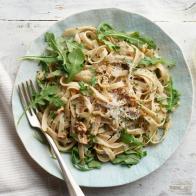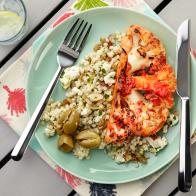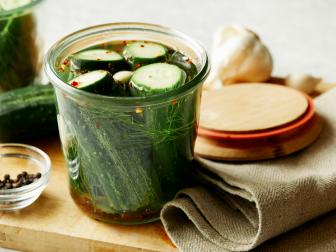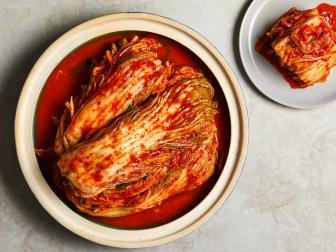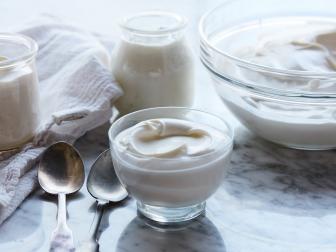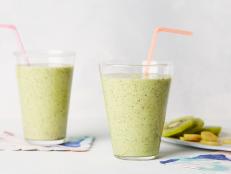Are You Eating Probiotics All Wrong?
Here are do’s and don’ts for getting the most out of good-for-your-gut bacteria.

Nungning20/Getty Images
Probiotics have gotten plenty of buzz for their health benefits – but if you don’t eat them right, you may not be getting all that they have to offer.
For example, those good bacteria found in yogurt can actually expire before the yogurt’s ‘best by’ date if you don’t store the yogurt correctly. And while sauerkraut can be a wealth of inflammation-fighting microorganisms, not all sauerkraut is packed with probiotics.
Read on to learn the do’s and don’ts of how to get the most out of probiotics.

SDI Productions/Getty Images
Do keep your yogurt and kefir refrigerated at all times.
Digging into a cup of yogurt may be the easiest way to eat more probiotics. And those good bacteria thrive in the dairy environment provided by yogurt. The natural sugars in yogurt and kefir help feed probiotics, which in turn produce even more beneficial metabolites for you to consume. Plus, probiotics stay viable in the refrigerator, which is where dairy foods are best stored. But even a 10-degree Fahrenheit temperature rise decreases yogurt probiotic survival.
Take an icepack or cooler to the store when yogurt or kefir are on your shopping list. And store it in the back of the bottom fridge shelf, which is the coldest location.
If you do forget to put your yogurt back in the fridge, it’s still safe to eat (and it’s still high in protein and other nutrients) even after two hours at room temperature (one hour at temps higher than 90 degrees F). Just know that time out of the fridge means that the number of strong healthy probiotics will be diminished.
If you’re not great at putting your yogurt back into the fridge after use, look for the hearty culture Lactobacillus rhamnosus.
Don’t use probiotics as a Band-Aid for a diet or lifestyle that’s not so healthy.
Excess alcohol consumption, smoking, lack of sleep, lack of exercise and other stressful lifestyle factors can wreak havoc on the gut. While moving away from these habits, probiotics can be a great way to heal the gut.
Do search for “live and active cultures.”
The “live and active cultures” seal appears on many yogurt and cultured dairy foods. Products with this seal have at least 100 million cultures per gram of product, which is 10 times higher than the minimum levels required by the U.S. Food and Drug Administration (FDA). The cultures present are Lactobacillus bulgaricus and Streptococcus thermophilus which convert milk to yogurt or kefir.
You can also find “contains active yogurt cultures” listed on the ingredients label. Some yogurt manufactures list out the cultures that they use. More is usually better: higher number of cultures and a greater variety of strains of cultures.
Some shelf-stable yogurts do not contain probiotics, so you will not see “active cultures” on the label.

kuppa_rock/Getty Images
Don’t (always) cook miso, kimchi or sauerkraut.
Yogurt isn’t the only place to find probiotics. Fermented foods like sourdough starter, unpasteurized tempeh, kombucha, sauerkraut, miso and kimchi are teeming with live good bacteria. But cooking kills them.
However, not all is lost if you boil your miso soup, cook tempeh (which you should do) or, obviously, bake your sourdough bread.
Researchers have found that even when good microbes are not as viable or are dead, they can still provide benefits to your gut, probably because the components produced when these probiotics are digested are still beneficial.
Still, while many dishes call for some form of cooking, try to also eat those same probiotic-rich foods in their live state for the most gut – and brain benefits. That may mean having kimchi fried rice on some days, and eating kimchi as is as a side on others. And when cooking miso soup, trying your best not to let it reach boiling point, and reserving some of the ‘live’ miso to stir in after the soup has cooled a bit for even more benefits.
Do try this at home.
Sadly, the heat-treated vinegar pickles typically found in the shelf-stable pickle aisle are not fermented and do not have probiotic benefits.
But refrigerated fermented foods can be expensive to buy, especially if you’re feeding a family. A jar of refrigerated fermented pickles or sauerkraut can be gone after just one meal.
So how do you incorporate probiotics daily? One answer is to buy tubs of plain yogurt which is more affordable. But even that can be pricy. So making your own yogurt, sauerkraut or kimchi is budget-friendly. However, it does take time. The good news is that according to the USDA, there has never been a case of foodborne illness from pickling vegetables properly.
Try These Recipes
Don’t forget about prebiotics.
Prebiotics nourish probiotics. Prebiotics can be found in many plant foods including vegetables, fruits, whole grains, nuts, beans and lentils. Prebiotics include fiber and polyphenols (plant antioxidants).
And, if you choose the right prebiotics, they can also be sources of probiotics:
Kimchi and Sauerkraut: Prebiotics are found in the cabbage, radishes, carrots and other vegetables used to make these probiotic-rich foods.
Pickles: Almost any vegetable can be fermented into pickles.
Dried Fruits: Apricots contain prebiotics. Prunes contain more polyphenols than most other fruits, plus prunes contain the uniquely beneficial prebiotic sorbitol. Some companies also inoculate their fruits with probiotics.
Tempeh: While most store-bough tempeh is technically not a probiotic food because it’s pasteurized, it does contain beneficial prebiotic fiber.

Yagi-Studio/Getty Images
Do eat probiotics when you’re on antibiotics.
While it may seem counterintuitive, eating probiotics (and prebiotics) when on prescription antibiotics is a good idea. Probiotics can re-inoculate the intestinal lining with good microbes. Yogurt can also help prevent antibiotic-induced diarrhea; look for the strains: Lactobacillus acidophilus, Lactobacillus rhamnosus and Saccharomyces boulardii.
And after you finish the round of antibiotics, really double down on eating many different varieties of probiotics and prebiotics to help your gut get back on track.
*This article was written and/or reviewed by an independent registered dietitian nutritionist.
Related Content:
